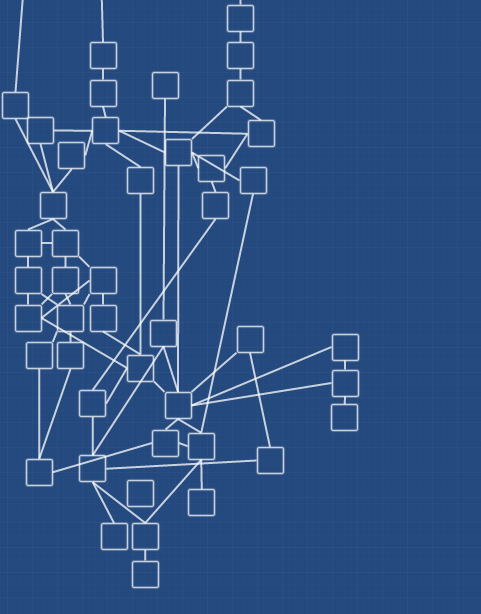I have a chart of the way scenes branch in the SNAFU story. You might have looked at that and thought “Well, that looks a tad complex” – or maybe you didn’t. Maybe you thought it looked quite straightforward compared to branching fiction that you’re familiar with.
For a refresher, this is a chunk of the diagram:
It has grown a little since then. The thing is, that traditionally, the scene is the “atomic” node of choice-based interactive-fiction, and that is not the case here.
When I say “atomic”, I mean it in its original sense, that is “indivisible”. You have a scene. You maybe have a choice or choices that determine what the next scene is, you read the next scene, make your choice and so on.
Yeah, this ain’t that.
Some of those boxes up there represent scenes with an atomic narrative like that, but not many of them. Mostly, those happen near the top, in the earlier parts of the prologue.
As we move on through the story, things get more intricate. One box might represent two, three, four or a dozen alternate versions of events, depending on what choices characters and the player/reader have made in the past, what information they have learned, what events have taken place. Narrative doesn’t navigate a graph of scenes, each scene may contain its own branching structure, depending on prior events/choices/information.
The map of scenes up there is just a convenience, for me, allowing me to lump narrative into abstract logical units, so I can actually find things, and track what areas of the story are and are not done.
Some of it looks more traditional. For example, scene 250 and scene 260 are quite different. Not all of the same characters are present in both scenes, though they have some events in common, and play out in very different ways. They’re definitely alternative versions of events at the same place and time, though. The pair of them are monstrously large scenes with a roughly a dozen playable characters present at once. That acts as a multiplier on both word-count and variations. There’s no way I’m getting through those scenes without spending at least 3,000 words per playable character for each scene.
On the other hand, scene 114 follows on from three different scenes, and has three similar but distinct narratives depending on what has happened previously. Three variations, and only a few dozen words each. Hardly worth mentioning!
Scene 363, on the other hand, which on the chart is a single box with a single arrow in and a single arrow out, has eighteen variations (and three different characters make up to four different choices) running to nearly 8,000 words in total. It will also probably take the reader less than a minute to read through, on average. Much of the variation within that scene depends as much on past choices as it does on choices made within the scene, and the consequences of choices made during it will affect much of the narrative to come. But as the player/reader, that probably won’t exactly be very obvious.
The good part about all of this is that I’m managing to largely avoid the exponential creep in branching fiction. The choices made by characters don’t always fundamentally change the course of events – there are factors external to the characters that are simply beyond their control. Those choices, however, do alter the story for the characters themselves – and the creep on that is actually much more controllable.
What a character knows, the experiences they’ve had, and the consequences of the choices they’ve made all contribute to variations on the story of the character and the stories of the character around them. It may also influence broader events, but the events surrounding them are a story of its own, and one which may not be so easily turned aside. That keeps things … manageable.
Wordy, but manageable.
